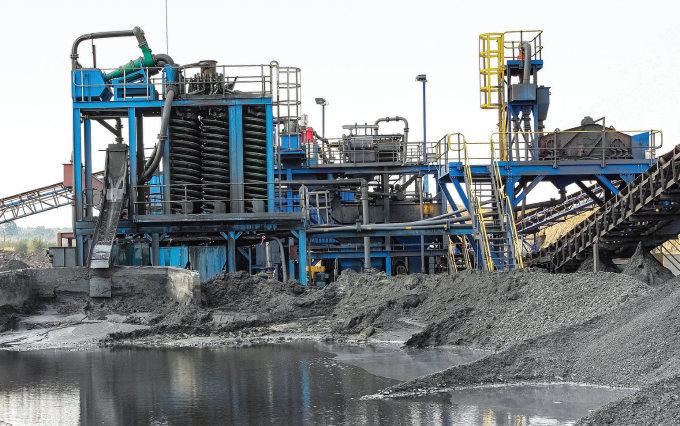
19 minute read
Mining
Water management in mining
Water plays many key roles in the mining industry and is used for a broad range of activities including mineral processing, dust suppression, slurry transport, as well as meeting the potable water needs of employees. Tim Guest reports.
Image Credit: Adobe Stock
Mining companies across Africa face a variety of mine water challenges.
Mining companies across Africa face a variety of mine water challenges, often depending on their location (e.g. isolated, or near population centres) and type (e.g. surface/open cast versus underground, etc). From the production of potable water using processes such as desalination in remote locations, to the processing and treatment of wastewater both from human activities, as well as wastewater from mining, whether hard and soft rock mining or solution mining, each require the use of water treatment methods of one sort or another.
With so many factors involved, mining companies outsource such requirements to specialist players like Veolia Water Technologies and SGS SA. Companies such as these provide a range of mining water treatment and filtration services like preliminary and detailed engineering, standard and custom water treatment equipment, project management, cyanide detoxification, effluent treatment, highdensity sludge processing, as well as full maintenance and support on a long-term basis to ensure all aspects of water at a mine are handled properly.
This allows the operator to remain focused on its core mining activities in the knowledge that such things as proper water treatment and discharge compliance are in line with respective national environmental protection effluent discharge requirements, and are in the hands of experts.
A crucial undertaking
Many mines in Africa face climate fluctuations
with high seasonal temperature variations and the alternation of dry and wet periods. When seasonal patterns provide very high rainfall for only a few months, water must be managed cautiously to avoid flooding of operations, which could lead to water contamination and potential health and safety issues, as well as local environment pollution, particularly when such activities as gold extraction require the use of cyanide to dissolve and separate gold from ore.
This makes effective water management crucial, as not only does it help improve productivity and manage environmental risks by treating contaminated water, such treatment can also achieve water quality suitable for re-use, or for safe discharge into the environment.
It can also help add value to the mine operator’s bottom line by treating sludge streams to recover valuable suspended and dissolved constituents. And, importantly, compliant mine water treatment processes will help an operator ensure its local, social licence to operate is not jeopardised through neglect of any aspect of water management.
Transparent reporting is important so that stakeholders have greater line of sight over mining companies’ water management practices and related data.”
AIDAN DAVY, COO, ICMM
ICMM on Corporate Water Reporting
In August, the International Council on Metals and Mining (ICMM) published updated guidance to improve the quality and consistency of corporate water reporting in its latest: Water Reporting: Good Practice Guide, in order to improve the quality and consistency of corporate water reporting to enhance stakeholders’ understanding of, and ability to use, water reports and associated data. The ICMM, which has 28 members operating in 50 countries, including throughout sub-Saharan Africa, said the guidance broadens its minimum reporting commitments to include new metrics for disclosure, such as holistic reporting of how water is used to meet operational demands and how it is actively managed.
The update includes reporting of aggregated water metrics for all sites within a company, as well as a separate aggregated total for all sites situated in water-stressed areas, such as some remote regions in Africa. It supports mining companies to disclose water data in a consistent way for easier comparison of performance by interested stakeholders.
The updated ICMM guide builds directly on external reporting guidance and definitions, including CEO Water Mandate, GRI, CDP Water and the MCA Water Accounting Framework. It captures practical experience from companies operating in diverse geographies, commodities and regulatory systems, and was developed in consultation with industry experts and investors, ensuring its relevance as a global tool for all mining sites across Africa and beyond.
In a statement, Aidan Davy, COO, ICMM said, “Transparent reporting is important so that stakeholders such as investors, government, local communities and civil society have greater line of sight over mining companies’ water management practices and related data.”
The external reporting landscape is evolving, according to Davy, and ICMM’s updated Water Reporting: Good Practice Guide should help companies strengthen their management of what he calls ‘this precious and shared resource’ for the benefit of all users, while reducing corporate risk exposure.
ICMM members, of which African Rainbow Minerals, Anglo American Mining, Glencore and SibanyeStillwater are just some with interests across Africa, can also call on the ICMM’s ‘A Practical Guide to Consistent Water Reporting’, in their water management activities. ■
Water testing at Der Brochen Platinum mine, a platinum project in South Africa owned by Rustenburg Platinum Mines Limited (RPM), a wholly-owned subsidiary of Anglo American Platinum (AAP). RPM is in the process of amending the mine’s approved Environmental Management Programme and associated Environmental Authorisation, as well as updating its existing Water Use Licence.

Terex MPS provides complete range of crushing and screening equipment
The equipment of Terex Minerals Processing Systems (Terex MPS) is most commonly set up in primary, secondary, tertiary and quaternary crushing positions. Units are available with numerous options and can be integrated with almost any portable crushing system.
The MJ55 Modular Jaw Crusher has been created to meet a wide range of crushing and screening applications. All modules are preengineered and pre-built to operate on a small footprint with low civil work and operating costs and easy on-site assembly. The modules and components can be easily transported in standard shipping containers or by road, enabling customers to quickly mobilise on site. The Modular range is designed for large quarries or contractors that want a stationary type design without the complexity of a normal stickbuilt plant.
Terex MPS also leads the industry with the most advanced portable plants, which now include the all new WJ3042 and WC1150S highcapacity, all-electric wheeled crushing systems. They’re quick to set up and dismantle, as well as easy to operate. The Terex WJ3042 is a highperformance wheeled jaw crusher plant, incorporating the aggressive Terex JW42 jaw crusher and a heavy duty vibrating grizzly feeder, enabling optimum production. Its compact size, quick set up times, ease of transport and simple maintenance make it ideal for quarrying, mining, demolition and recycling.
The Terex WC1150S Cone-Screen plant is a high performance, medium-sized wheeled crushing-screening system. At the heart of the plant is the 225 kW Terex TC1150 cone crusher with a modern automated control system. Its crushing action provides excellent capacity, high reduction and good product cubicity for the production of high-quality aggregate and subbase materials.
The WJ3042 and WC1150S are available as stand-alone plants or as part of a multi-plant system with product conveyors for a complete crushing and screening solution. All plants and conveyors are designed to fit in standard containers for easy transport overseas or on the road. The entire system with conveyors can be transported in nine containers. Once on site, each assembled plant can be transported in a one-piece tow.
Simplicity SI screens
Equipped with many new features, the latest series of Simplicity Standard Incline (SI) screens from Terex MPS’ Static solutions are designed for heavy duty, medium and fine screening applications. The SI screens are built with a robust drive mechanism to handle large tonnages and a wide variety of applications. Utilised as wet or dry screens, these units have adjustable stroke and speed combinations to fit a variety of applications and are available in 2or 3-deck configurations.
Image Credit: Terex MPS

The Terex WJ3042 is a high-performance wheeled jaw crusher plant.
BKT SOLUTIONS FOR THE MINING SECTOR

SPONSORED CONTENT
Severe mining operation, rough terrain and longer operating hours are all real challenges for the machines working in the mining sector and, above all, for the tires fitted to them. It is therefore essential for operators to be able to count on reliability and the least down time from tires that can withstand cuts and tears. This guarantees a prolonged product life cycle, while also providing traction and stability. Machine down time due to tire damage during service would not only mean extra cost, but would also impact on productivity.
That is why BKT wished to pay particular attention in developing tires suitable for this type of application, studying them closely in minute detail.
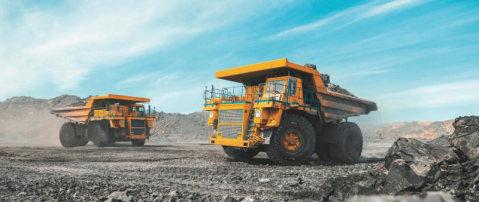
BKT's EARTHMAX range
The tires in BKT's EARTHMAX range are designed for the toughest operations. They are a broad range of radial solutions designed to facilitate the best possible ground load distribution for dump trucks, wheel loaders, dozers, and graders.
All EARTHMAX tires are distinguished by their All Steel structure which provides resistance to the casing and so against impacts. These are essential features when faced with particular obstacles on the ground which could expose the tire to serious risk of puncture or damage to the casing.
In particular, this range includes three models which, thanks to their large size, are particularly suitable to handling mining operations under the toughest conditions: • EARTHMAX SR 46: Developed for large rigid dump trucks which operate in severe mining operation. This tire guarantees a high level of resistance to cuts thanks to its casing with a steel belt. The specific design of the tread with blocks and grooving on the circumference guarantees reduced damage to the surface of the product and improved performance on bends. • EARTHMAX SR 45: Designed for rigid dump trucks and has a specific design of blocks and a deeper tread, which renders high traction in specific mine operation and extend tire life. • EARTHMAX SR 53: Classified L-5, this tire has been designed for loaders operating in difficult conditions. The tread consists of a compound which is particularly resistant to cuts. In addition, it is designed to offer extraordinary self-cleaning properties, which facilitate the expulsion of stones and other foreign bodies.
BKT's EARTHMAX range are designed for the toughest operations.
Image Credit: BKT
Giant tires
In response to market demand, BKT has also launched a Giant version of EARTHMAX SR 46 for rigid dump trucks operating at mines, dams and large worksites. This solution is available in the largest size which BKT has ever made: 33.00 R 51. With a diameter of over three meters, this tire weighs 2,400 kg.
Pushing ahead with digital transformation
According to a new study by Axora, the metals and mining sector is driving forward with digital transformation, but there is still more to be done ahead of the energy transition.

Historically metals and mining has adopted digital technology at a slower pace than many other industries.
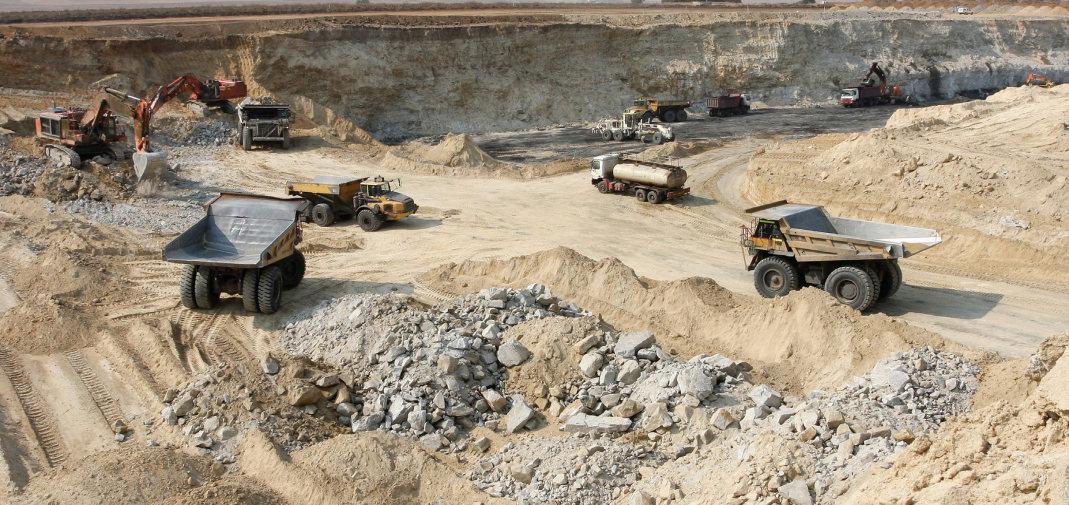
The ‘Axora 2021 Innovation Forecast: Metals and Mining’ report, which was based on a survey of 150 senior decision makers worldwide, states that historically metals and mining has adopted digital technology at a slower pace than many other industries.
Ritz Steytler, CEO of Axora, said, “The highly variable nature of mining is partially responsible for this reticence, as are the remote and heavy environments in which companies operate. Additionally, the industry is still at a nascent stage when it comes to bringing digital skills to mine sites.
“But although digital deployment has historically moved at a measured pace, there’s now a growing need for companies to unlock its benefits through a more coordinated and strategic approach. As the industry emerges from the Covid-19 pandemic, digital transformation is necessary to boost production efficiency and reduce costs across operations.”
Key findings from the report include:
Meeting the rising demand from the energy transition
99% of decision makers now believe technology and innovation are critical to their organisation’s survival and 94% of respondents said their deployments were advanced or intermediate. Those in North America, the UK and South America saw themselves as most advanced, whereas South Africa saw itself as least advanced.
Digital solutions and AI
There is more focus on using technology to boost direct productivity, foster a better working environment and improve ROI than to prevent downtime and companies are taking a longerterm view when it comes to cost savings from digital transformation. In the next two years, 24% of respondents anticipate saving 1-5% from digital technology. Within five years, just 3% of respondents anticipate that level of savings, with most predicting 11-15%. More than three-quarters of respondents prioritised the value of digital technology over its cost. 57% of decision makers said their organisation had deployed AI to some extent and 59% ranked it first for growth potential in the next year, followed by robotics at 45%.
Analytics, semi-autonomous equipment and remote operations
73% of respondents said they had deployed analytics and semi-autonomous equipment to some extent with the latter the most likely to be 100% deployed across the organisation. 73% of organisations have deployed remote operations technology and 72% of respondents said their company had implemented a remote operations centre, with a further 15% saying they are planning to do so in the next year.
Drivers for change
82% of respondents said a partner had the biggest influence on their digital technology adoption, with the preference being for generic rather than industry-specific ones and 99% said they would benefit from a digital transformation community where they could learn from peers’ experiences with different technologies and applications. ■
CAT D11 XE DOZER HARNESSES THE POWER AND EFFICIENCY OF ELECTRIC DRIVE
Cat Image Credit:
The Cat D11 XE Dozer.
Leveraging 20-plus years of Cat electric drive experience and field application, the new Cat D11 XE dozer’s electric drive system delivers constant power to the ground, continuous pushing and greater manoeuvrability for faster cycle times and improved fuel efficiency. It was previewed at MINExpo 2021.
The D11 XE delivers the lowest cost per ton operation in dozing applications and, when in production, the model will be the world’s largest, most powerful and efficient electric drive dozer with high drive.
Targeting up to 25% less fuel costs per BCM, the D11 XE targets up to 20% longer engine rebuild cycles than mechanical drive models, while 60% fewer moving parts translates to better machine uptime availability.
The D11 XE fully integrates Cat powertrain, Cat electronics, Cat software and Cat controls for optimised performance. Inherent machine protection reduces component damage for improved reliability and its updated electronics architecture allows the dozer to take advantage of proven Cat technologies like MineStar Command for dozing, which offers both remote control and semi-autonomous dozing.
With a powertrain life targeted to deliver longer rebuild intervals, the simple machine design delivers less major component rebuilding and/or replacing. Longer rebuild cycles, lower fuel consumption and less maintenance come together with higher machine efficiency to give owners the lowest cost of bank cubic meters (BCM) of material moved ever.
Currently operating at one of Caterpillar’s dozer proving grounds, the D11 XE will complete an extensive field validation plan before entering full production.
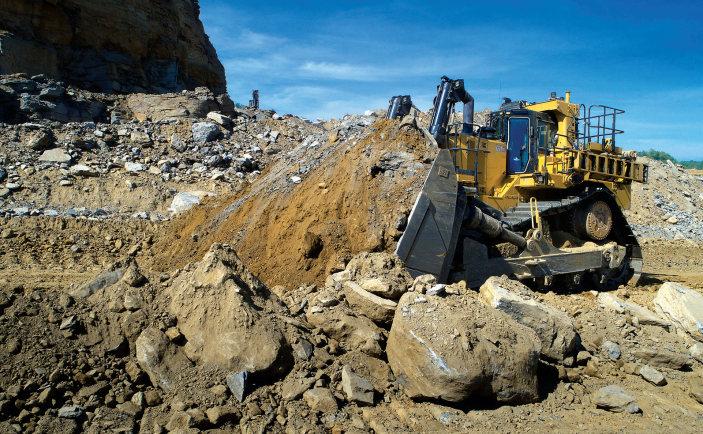
FINANCIAL SOFTWARE SOLUTION FOR GOLD MINERS
Nordgold plc, the internationally diversified one million ounce gold producer and global IT consultancy Columbus has launched, "CN Planning Analytics for the Mining Industry", an innovative corporate finance software solution tailored specifically to meet the challenges of the resources industry, in particular the gold sector.
CN Planning Analytics is a software-based tool which provides a user friendly interface that facilitates the transparent planning, measurement, monitoring and reporting of gold mining companies' financial and operating performance.
CN Planning Analytics was designed to address gold miners' common challenges when planning, measuring, monitoring and reporting their activities.
The software includes preconfigured budgeting and management reporting models based on industry-specific KPIs. It is designed to work with different types of mining methods including open pit, underground and mixed as well as gold processing technologies (CIL, CIP, heap leaching and BIOX). CN Planning Analytics also allows data from mine planning IT platforms to be integrated into the gold mine's financial models, which, among other things, streamlines and facilitates long-term strategic financial planning.
Andrey Yudaev, business development director for information and analytical systems at Columbus, said, "Partnering with Nordgold to develop CN Planning Analytics was a unique collaboration that allowed us to combine the practical business experience of a mining company with the industry and product expertise of a consultancy. The solution's functionality has been proven by IBM and by its high performance in automating Nordgold's real-world business processes.”
Metso Outotec boosts iron ore pelletising plant performance
Metso Outotec is launching leading-edge digital solutions to ensure the optimal operation and maintenance of iron ore pelletising plants over the entire plant life cycle. Leveraging the company’s extensive experience as the original inventor of the pelletising process, Metso Outotec has developed a suite of solutions that will improve process performance, production capacity, and product quality while at the same time reducing energy consumption, environmental impact, and operation and maintenance costs.
The new digital solutions include the Metso Outotec Optimizing Control System OCS-4D and the Planet Positive Optimus advanced process control system for ensuring a stable and efficient process, the VisioPellet pellet size-control system for optimising the pelletising process, and the pallet car condition monitoring system for improving preventive maintenance planning and execution.
In addition, Metso Outotec is launching a unique operator training with advanced simulation technology in a risk-free virtual plant environment. The training can be tailored to simulate different operating conditions, standard procedures, emergency situations, and any other operational scenarios that are deemed to be beneficial.
“We are really excited about these new digital products. Based on pilot tests/refence cases, we know that they can make a true difference for our customers’ processes. These solutions can be implemented in all iron ore pelletising plants delivered by Metso Outotec. Our experts are happy to give more information on how each of these would benefit and work in individual plants,” said Olavo Nolasco, director, product competitiveness, ferrous & heat transfer at Metso Outotec.
Image Credit: Metso Outotec
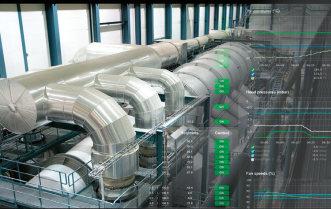
The M1700X was featured alongside the FM120 C25, which allows sand to be recovered when both mqachines are connected.
MRTA offers training beyond own facilities
The Murray & Roberts Cementation Training Academy (MRTA), in a quantum leap for training in the underground mining sector, is strategically positioning itself to take its world class learning systems to customers on their own sites.
This move, according to Murray & Roberts Cementation education, training and development (ETD) executive Tony Pretorius, incorporates the use of remote elearning solutions coupled to Dover Assessment for psychomotor skills, VR Simulation, mass assessment tools and classroom response systems.
“It is an exciting step beyond the MRTA’s industry-leading facilities at Bentley Park near Carletonville, and opens doors for companies to generate and upgrade skills even during the Covid-19 pandemic,” Pretorius said.
“Making use of the latest technologies –such as interactive touchscreens – we can now offer two-dimensional and threedimensional training interventions,” he continued. “This can be deployed with virtual reality (VR) training modules, including the use of VR simulators that we are developing with our strategic technology partner, Simulated Training Solutions (STS).”
Among the high-tech advances being driven by the academy is a portable VR drill rig. The portfolio of ground-breaking training tools will be easily transported in a purposedesigned trailer to sites convenient to the customer – even on mines themselves.
In addition to regulatory restraints, this new training infrastructure could also reduce the cost of having staff attend off-site training for extended periods – where costs are raised by travel and accommodation.
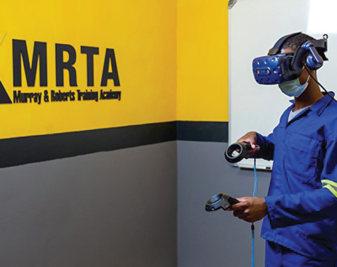
The academy’s new age of training systems will also be rolled out within the projects of Murray & Roberts Cementation itself.
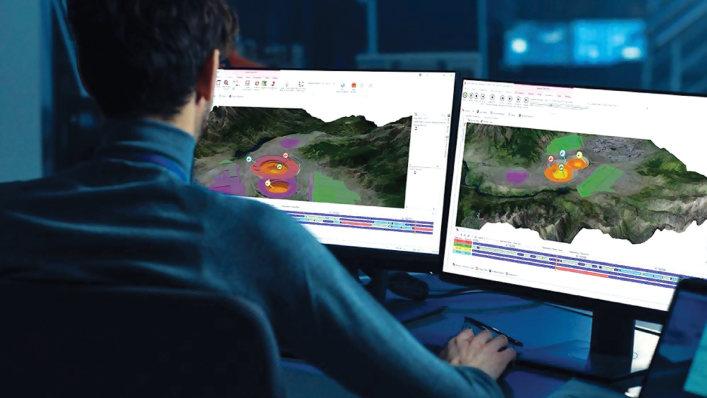
Users will no longer have to take a mine schedule and manually place it into a GIS system.
RPMGlobal has introduced an environmental disturbance modelling and reporting functionality into its leading mine scheduling products, XPAC Solutions
Unlike a simple reporting tool, XPAC Solutions has the capability to restrain a mining schedule based on pre-set limits associated with both water catchment and flora and fauna zones. For example, users can request a reduction in an environmental distance of some type and the software will then proceed to find a different schedule that honours that restriction.
This new module is required because organisations now need to plan and report how much environmental disturbance has taken place in specified areas, allowing organisations to plan better when applying for, and receiving ground disturbance permits.
With RPMGlobal’s automatic environmental disturbance reporting functionality, users will no longer have to take a mine schedule and manually place it into a GIS system to build environmental reports.
RPMGlobal’s head of ESG, Ngaire Tranter, said the environmental disturbance capability would be critical for companies operating in jurisdictions that have stringent environmental restrictions.
“Across many jurisdictions, policy makers and regulators are strengthening environmental disclosure requirements which underpin the importance of innovative software solutions that help mining companies navigate this evolving space.”
The development project follows the completion of the company’s electric vehicle simulation capabilities which sit inside the company’s vehicle simulation suite of software. Separately, development has commenced to also include hydrogen-powered haul trucks.
Mining technology company Chrysos Corporation has achieved a significant milestone by installing its first international PhotonAssay unit at Barrick Gold’s Bulyanhulu mine in Tanzania.
Originally developed at Australia’s national science agency, CSIRO, Chrysos PhotonAssay delivers faster, safer and more accurate gold analysis, and is an environmentally friendly replacement for fire assay on-site and in the laboratory. Hitting samples with high-energy X-rays, the technology causes excitation of atomic nuclei allowing enhanced analysis of gold, silver and complementary elements in as little as two minutes.
Dirk Treasure, CEO, Chrysos Corporation, enthused, “We are confident that PhotonAssay’s faster, safer and environmentally-friendly process not only aligns with Barrick’s focus on operational excellence through technology adoption, but also reflects and enhances its global reputation as a leader in sustainable mining and exploration.”
Continuing the ESG theme, Treasure added, “Our ambitious plan is to deploy 80 PhotonAssay units over the next five years. At that point, with each unit capable of processing up to 480,000 samples per annum, we will be helping our customers reduce CO2 emissions by an estimated 18,000 tonnes and decrease hazardous waste by approximately 12,000 tonnes every year.”
Market enthusiasm for these operational and environmental benefits has endowed Chrysos with a strong sales pipeline and new contracts for a further nine units; representing 150% growth on its current deployments.






